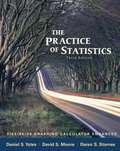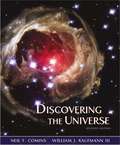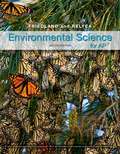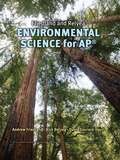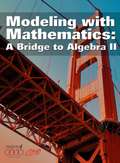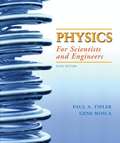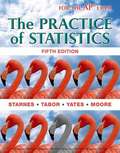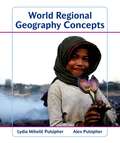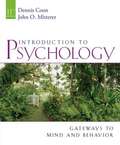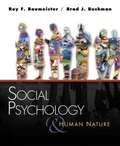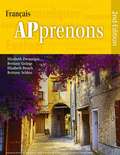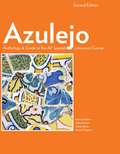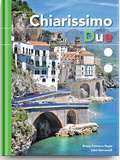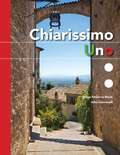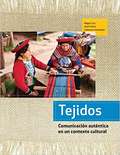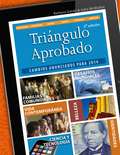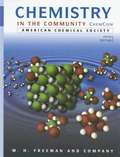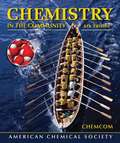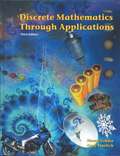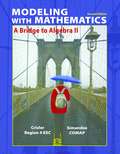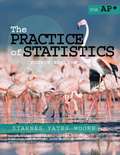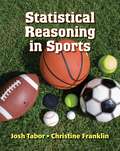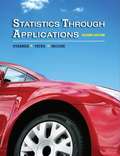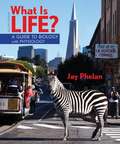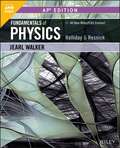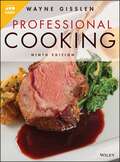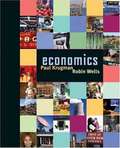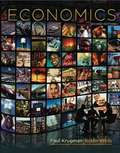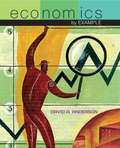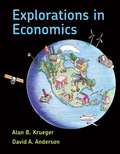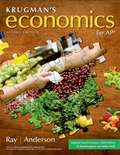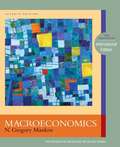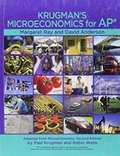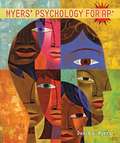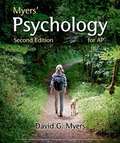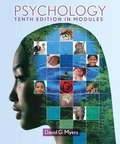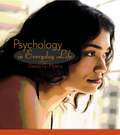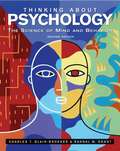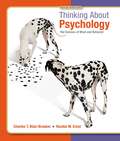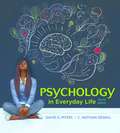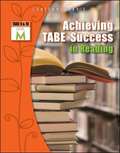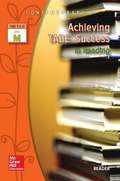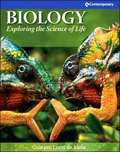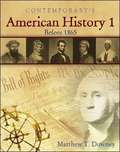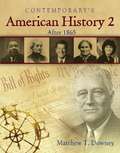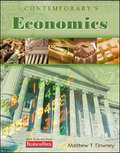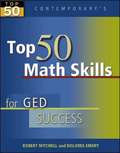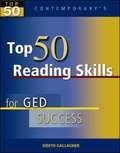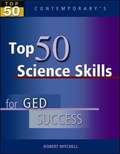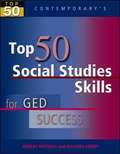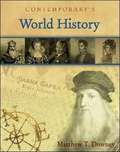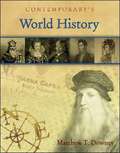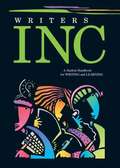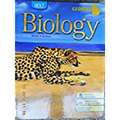- Table View
- List View
More NIMAC books are available at www.nimac.us. If you find your title in the NIMAC and not in Bookshare then please contact us to request it.
The Practice of Statistics: TI-83/84/89 Graphing Calculator Enhanced
by David S. Moore Daniel S. Yates Darren S. StarnesNIMAC-sourced textbook
Discovering the Universe
by Neil F. Comins William J. KaufmannComins (U. of Maine) and Kaufmann (San Diego State U. ) introduce the new features of the seventh edition of this well-illustrated introductory text (dates of previous iterations are not given), including updated information on planets in our solar system and extra-solar planets; new appendixes on math, graphs, and constellations; and novel ways of presenting examples of concepts. Special features include "an astronomer's toolbox," advanced computational questions, Web-based questions, and observational projects. The included CD-ROM contains an interactive electronic planetarium. Annotation ©2006 Book News, Inc. , Portland, OR (booknews. com)
Environmental Science for AP®
by Andrew Friedland Rick RelyeaFriedland/Relyea Environmental Science for AP* was written specifically for the AP* Environmental Science (APES) course, directly addressing the needs of APES students and teachers from beginning to end. Lead author Dr. Andrew Friedland of Dartmouth College was the founding Chair of the College Board committee that created the APES course. He regularly teaches Introduction to Environmental Science at Dartmouth and is actively researching environmental science topics related to air pollution and carbon accumulation in forests. The Friedland package uniquely prepares students for the quantitative aspects of the APES course in a way no other text does. In addition, it explores and explains every topic within the APES course description while offering a scientific and balanced approach to the key concepts. The Friedland text is praised for its accessibility and for familiarizing students with the findings that inform environmental decision making at all levels—from personal choice to national and international policy.
Friedland and Relyea Environmental Science For AP
by Andrew Friedland Rick Relyea David Courard-HauriFriedland/Relyea Environmental Science for AP* was specifically developed to meet the requirements of the AP Environmental Science course and the needs of its students and teachers. This highly anticipated new textbook explores the sciencebehindenvironmental science and involves students with the fundamental concepts and findings that inform environmental decision making at all levels—from personal choices to national and international policy.
Modeling with Mathematics: A Bridge to Algebra II
by Sharon Benson Roland Cheyney David Eschberger Jo Ann WheelerAn innovative course that offers students an exciting new perspective on mathematics,Modeling With Mathematicsexplores how mathematics can help explore problems real people encounter in their jobs and lives. Mathematical modeling and a data-driven approach to exploring functions helps students deepen their mathematical skills and maturity. Modeling With Mathematics: A Bridge To Algebra IIhas been designed for students who have completed Algebra I or Algebra I and Geometry but need review practice and motivation to succeed in Algebra II. In addition the course gives students a look ahead to many Algebra II topics. Modeling With Mathematics: A Bridge To Algebra II list serv http://www. whfreeman. com/bridgelistserv. pdf As a service to instructors usingModeling With Mathematics: A Bridge To Algebra II, a listserv has been designed as a forum to share ideas, ask questions and learn new ways to enhance the learning experience for their students.
Physics for Scientists and Engineers [Standard Version]
by Paul A. Tipler Gene MoscaThe Sixth Edition ofPhysics for Scientists and Engineersoffers a completely integrated text and media solution that will help students learn most effectively and will enable professors to customize their classrooms so that they teach most efficiently. The text includes a new strategic problem-solving approach, an integrated Math Tutorial, and new tools to improve conceptual understanding. To simplify the review and use of the text,Physics for Scientists and Engineersis available in these versions: Volume 1Mechanics/Oscillations and Waves/Thermodynamics(Chapters 1-20, R) 1-4292-0132-0 Volume 2Electricity and Magnetism/Light(Chapters 21-33) 1-4292-0133-9 Volume 3Elementary Modern Physics(Chapters 34-41) 1-4292-0134-7 Standard Version(Chapters 1-33, R) 1-4292-0124-X Extended Version(Chapters 1-41, R) 0-7167-8964-7
The Practice of Statistics
by Daren S. Starnes Josh Tabor Daniel S. Yates David S. MooreCombining a data analysis approach with the power of technology, innovative pedagogy, and a number of new features, this fifth edition has been updated to incorporate Learning Objectives in each section and link them to chapter reviews.
World Regional Geography Concepts
by Lydia Mihelic Pulsipher Alex A. PulsipherThe authors of World Regional Geography have answered the need for an exceptionally brief textbook for the evolving world regional course. In World Regional Geography Concepts, eight major thematic concepts frame the coverage and give students a way of approach the wealth of information in the text. Like the Pulsiphers' longer text, World Regional Geography Concepts emphasizes global trends and the interregional linkages that are changing lives throughout the world, humanizes geographical issues by representing the lives of women, men, and children in various regions of the globe.
Introduction to Psychology: Gateways to Mind and Behavior
by Dennis Coon John O. MittererPsychology Textbook
Social Psychology and Human Nature
by Brad J. Bushman Roy F. BaumeisterThe material discussed in this book is intensely relevant to your life. For example, how many of you have asked yourself something along these lines: How can I get him to go along with my plan? Should I ask her right up front to do this big favor, or is there a better way to get her to say yes? How can I bring them around to my way of thinking? Chances are, something in this book will prove helpful to you in the future. This is not to say that social psychology is a cookbook for how to manipulate people. But social psychology can help you understand basic principles of social influence, as well as many other principles of social behavior.
Apprenons: Francais
by Elizabeth Zwanziger Brittany Goings Elizabeth Rench Brittany Selden GriffinNIMAC-sourced textbook
Azulejo: Anthology & Guide to the AP Spanish Literature and Culture Course
by María Colbert Abby Kanter James Ryan Marian SuganoNIMAC-sourced textbook
EntreCulturas 3: Communicate, Explore, and Connect Across Cultures
by Deborah Espitia Pamela García Jennifer Cornell Isabel Vázquez GilNIMAC-sourced textbook
Tejidos: Comunicación Auténtica En Un Contexto Cultural
by Megan Cory Janet Parker Catherine SchwenklerNIMAC-sourced textbook
Chemistry in the Community
by American Chemical Society"Chemistry in the Community is a post-secondary chemistry course structured around applied community issues related to chemistry rather than around specific chemical concepts. Concepts are presented on a ""need-to-know"" basis, allowing students to experience chemistry on first hand. The course is about 50% laboratory-based, and features activities where students must apply their chemistry knowledge to realistic decision-making situations."
Chemistry in the Community
by American Chemical Society"Chemistry in the Community is a post-secondary chemistry course structured around applied community issues related to chemistry rather than around specific chemical concepts. Concepts are presented on a ""need-to-know"" basis, allowing students to experience chemistry on first hand. The course is about 50% laboratory-based, and features activities where students must apply their chemistry knowledge to realistic decision-making situations."
Chemistry in the Community: Chemcom
by American Chemistry SocietyNIMAC-sourced textbook <P><P>Touted as the most successful NSF-funded project published, Chemistry in the Community (ChemCom) by the American Chemical Society (ACS) offers a meaningful and memorable chemistry program for all levels of high school students. ChemCom covers traditional chemistry topics within the context of societal issues and real-world scenarios. Centered on decision-making activities where students are responsible for generating data in an investigating, analyzing that data and then applying their chemistry knowledge to solve the presented problem. The text is intensively laboratory-based, with all 39 of the investigations integrated within the text, not separate from the reading. With the ChemCom program, students learn more organic and biochemistry, more environmental and industrial chemistry, and more on the particulate nature of matter than other textbooks all within the relevance of solving problems that arise in everyday life. <P><P>Meticulously updated to meet the needs of today's teachers and students, the new sixth edition of ChemCom adheres to the new science framework as well as the forthcoming next generation of science standards. Incorporating advances in learning and cognitive sciences, ChemCom’s wide-ranging coverage builds upon the concepts and principles found in the National Science Education Standards. Correlations are available showing how closely aligned ChemCom is to these and other state standards
Modeling with Mathematics: A Bridge to Algebra II
by Nancy Crisler Gary SimundzaWith the emphasis the Common Core State Standards (CCSS) places on modeling, Modeling With Mathematics: A Bridge to Algebra II (Bridge 2e) addresses these modeling requirements while helping prepare students for success in Algebra II. Intended for students who have taken Algebra I and Geometry but who are not yet ready for Algebra II, this program helps solidify their understanding by providing a different kind of learning experience. With Bridge 2e students model real-world applications with a functions approach netting a deeper grasp of the important concepts necessary for success in Algebra II and on the forthcoming Common Core assessments.
The Practice of Statistics for AP
by Daren S. Starnes Daniel S. Yates David S. MooreCombining a data analysis approach with the power of technology, innovative pedagogy, and a number of new features, the fourth edition is an impressively effective text for learning statistics.
Statistical Reasoning in Sports
by Josh Tabor Christine FranklinOffering a unique and powerful way to introduce the principles of statistical reasoning, Statistical Reasoning in Sports features engaging examples and a student-friendly approach. Starting from the very first chapter, students are able to ask questions, collect and analyze data, and draw conclusions using randomization tests. Is it harder to shoot free throws with distractions? We explore this question by designing an experiment, collecting the data, and using a hands-on simulation to analyze results. Completely covering the Common Core Standards for Probability and Statistics, Statistical Reasoning in Sports is an accessible and fun way to learn about statistics!
Statistics Through Applications
by Daren S. Starnes Daniel S. Yates David S. MooreWatch avideo introduction here. Statistics Through Applications (STA)is the only text written specifically for high school statistics course. Designed to be read, the book takes a data analysis approach that emphasizes conceptual understanding over computation, while recognizing that some computation is necessary. The focus is on the statistical thinking behind data gathering and interpretation. The high school statistics course is often the first applied math course students take. STAengages students in learning how statisticians contribute to our understanding of the world and helps students to become more discerning consumers of the statistics they encounter in ads, economic reports, political campaigns, and elsewhere. New and improved!STA 2efeatures expanded coverage of probability, a reorganized presentation of data analysis, a new color design and much more. Please see theposted sample chapter orrequest a copy today to see for yourself.
What Is Life? A Guide to Biology with Physiology
by Jay PhelanThe most successful new non-majors biology textbook in a decade returns in a vigorously updated new edition--with every chapter of the book carefully revised by Jay Phelan, based on the feedback of hundreds of instructors and students. The Second Edition brings forward the book's hallmark features (clear and consistent illustrations, beautiful photographs, Take-Home Message summary sections, StreetBio: Knowledge You Can Use, and Red Q Questions) while adding new pedagogy, updated content, and expanded media/supplements package. Click here to watch a sample of our Lecture Videos featuring What Is Life? with Physiology author, Jay Phelan.
Economics, 1st Edition
by Paul Krugman Robin WellsKrugman/Wells takes a story-driven approach that focuses on real-world economics at work. The book offers the hallmark clarity and engaging writing style that distinguish Paul Krugman's work, from his best-selling international economics text to his "New York Times" best-sellers.
Economics, 2nd Edition
by Paul Krugman Robin WellsThe same unique voice that made Paul Krugman a widely read economist is evident on every page of Economics. The product of the partnership of coauthors Krugman and Robin Wells, the book returns in a new edition. The new edition is informed and informative, solidly grounded in economic fundamentals yet focused on the realities of today's world and the lives of students. It maintains the signature Krugman/Wells story-driven approach while incorporating organizational changes, new content and features, and new media and supplements. Watch a video interview of Paul Krugman here.
Economics by Example
by David AndersonLively, surprising, yet filled with solid economic content, Economics by Example is for students who want to understand why they should study economics while in the process of learning it This concise paperback introduces economic principles in the context of real-life applications, with much to say about how the economic way of thinking can improve students' decisions. Economics by Example was created to support traditional texts but it can also be used on its own, in courses requiring minimal mathematics or graphical analysis.
Krugman's Microeconomics for AP*
by Margaret Ray David AndersonKrugman’s Microeconomics for AP* combines the successful storytelling, vivid examples, and clear explanations of Paul Krugman and Robin Wells with the AP* expertise of Margaret Ray and David Anderson. In this exciting new AP text, Ray and Anderson successfully marry Krugman’s engaging approach and captivating writing with content based on The College Board’s AP Economics Course outline, all while focusing on the specific needs and interests of high school teachers and students.
Myers' Psychology for AP*
by David G. MyersAlready The Bestselling AP* Psychology Author, Myers Writes His First Exclusive AP* Psych Text. David G. Myers is best known for his top-selling college psychology texts, used successfully across North America in thousands of AP* courses. As effective as Myers' college texts have been for the AP* course, we believe his new text will be even better, because Myers' Psychology for AP* has been written especially for the AP* course!
Myers' Psychology for AP®
by David G. MyersThus begins market-leading author David Myers’ discussion of developmental psychology in Unit 9 of his new Myers’ Psychology for AP® Second Edition. With an undeniable gift for writing, Dr. Myers will lead your students on a guided tour of psychological science and poignant personal stories. Dr. Myers teaches, illuminates, and inspires. Four years ago, we published this ground-breaking text which is correlated directly to the AP® course. Today, we build on that innovation and proudly introduce the 2nd AP® Edition. Whether you are new to AP® psychology or have many years under your belt, this uniquely AP® book program can help you achieve more.
Psychology
by David G. MyersThis modules-based version of Myers' Psychology tenth edition breaks down the book's 16 chapters into 54 short modules. The condensed text allows students to better grasp and explore psychological concepts. It also makes for more flexibility in teaching, as cross-references to other chapters have been replaced with brief explanations.
Psychology (8th edition)
by David G. MyersSwitching among several differing perspectives, this introductory textbook describes what scientific research has learned about the biology underlying human behavior and mental processes, changes during the life cycle, states of consciousness, learning and memory, intelligence, emotion, personality, and psychological disorders. The seventh edition adds a new section on motivation in the workplace, and a psychology timeline inside the hardcover. Annotation ©2004 Book News, Inc., Portland, OR (booknews.com)
Psychology in Everyday Life, 1st edition
by David G. MyersLEARN IT. LIVE IT. Why take psychology? What makes psychology a science? Can it really help me understand my feelings and behaviors? Or how I get along with family and friends? Now from the world's foremost author for the introductory psychology classroom comes a new textbook that makes learning about the psychology of our lives a captivating experience for students at all levels. Carried by the author's acclaimed empathetic voice, Psychology in Everyday Life is David Myers' most inviting text to date. This new book represents a breakthrough in the interplay of text and visuals, yet, as always, provides a rich source of scientific insights into the lives we live. Any student, regardless of age or background, will find it a text that speaks directly to him or her, and will embrace it not just for its grade-raising potential, but for its revelations about what makes a person a stronger student, a more tuned-in friend or partner, a more effective worker, or a wiser parent.
Thinking About Psychology: The Science of Mind and Behavior
by Charles Blair-Broeker Randy Ernst David G. MyersWritten to promote critical thinking, captivate students, and satisfy the APA standards for high school psychology,Thinking About Psychologyis an introduction to high school psychology unlike any other. In a convenient and effective modular format, it presents psychological science in a rigorous yet non-threatening way, with immediate examples that help high school students bridge the abstract to the familiar.
Thinking About Psychology: The Science of Mind and Behavior
by Charles T. Blair-Broeker Randal M. ErnstSpecial Consultant:David G. Myers, Hope College, Holland, Michigan Appropriate Course:High school-level psychology [not Advanced Placement] In a convenient and effective modular format,Thinking About Psychology offers a rigorous presentation of psychological science in a non-threatening way with numerous and immediate examples that help high school students bridge the abstract to the familiar. This book closely follows the American Psychological Association (APA) National Standards for the Teaching of High School Psychology, for which both Blair-Broeker and Ernst served as Task Force members.
Achieving TABE® Success in Reading Level M [Grade 9-12]
by Linda Kwil Sean Klunder Genevieve KelleyTheAchieving TABE Successfamily is designed to provide complete skill preparation and practice for TABE 9&10, encompassing Reading, Mathematics and Language, for levels E, M, D and A. This series of books will help students achieve NRA gain through targeted instruction that specifically addresses TABE 9&10 skills. Achieving TABE Success . . . workbookscontain the following features: TABE 9&10 Correlation Charts Each text contains a TABE 9&10 Correlation Chart that links each question to targeted skill lessons, enabling instructors and students to build a personalized study plan based on skill level strengths and weaknesses. Pre-tests and Post-tests Each workbook begins with a pre-test and a skills correlation chart to help diagnose strengths and weaknesses and determine TABE readiness. The format of each pre- and post-test matches that of the actual TABE test. Targeted TABE Skill Lessons Each lesson specifically targets a TABE skill. Students work with the innovative lesson format that provides step-by-step instruction to help insure success. The Mathematics lessons offer plenty of instruction and practice to help master each TABE skill. In the Reading and Language workbooks, the lessons are divided into four parts for a graduated approach to learning: Introduceclearly defines, explains, and illustrates the skill, and includes examples. Practicepresents work related to the skill just introduced. Applyreinforces the skill through activities and exercises. Check Upevaluates student comprehension. Unit Reviews and Math Glossary Unit reviews are divided into two parts: Review, which summarizes unit content, and Assessment, to determine student understanding. Mathematics texts contain a Glossary of Common Terms to help students with the language of math. Achieving TABE Success in Reading . . . Readersare coordinated with their respective Reading workbooks, to strengthen skills by applying examples and questions that are pertinent to the skill covered in the workbook. Text/TABE Level Content Level Level E 2. 0 - 3. 9 Level M 4. 0 - 5. 9 Level D 6. 0 - 8. 9 Level A 9. 0 - 12. 9
Achieving Tabe® Success in Reading Workbook, Level M [Grade 9-12]
by ContemporaryTheAchieving TABE Successfamily is designed to provide complete skill preparation and practice for TABE 9&10, encompassing Reading, Mathematics and Language, for levels E, M, D and A. This series of books will help students achieve NRA gain through targeted instruction that specifically addresses TABE 9&10 skills. Achieving TABE Success . . . workbookscontain the following features: TABE 9&10 Correlation Charts Each text contains a TABE 9&10 Correlation Chart that links each question to targeted skill lessons, enabling instructors and students to build a personalized study plan based on skill level strengths and weaknesses. Pre-tests and Post-tests Each workbook begins with a pre-test and a skills correlation chart to help diagnose strengths and weaknesses and determine TABE readiness. The format of each pre- and post-test matches that of the actual TABE test. Targeted TABE Skill Lessons Each lesson specifically targets a TABE skill. Students work with the innovative lesson format that provides step-by-step instruction to help insure success. The Mathematics lessons offer plenty of instruction and practice to help master each TABE skill. In the Reading and Language workbooks, the lessons are divided into four parts for a graduated approach to learning: Introduceclearly defines, explains, and illustrates the skill, and includes examples. Practicepresents work related to the skill just introduced. Applyreinforces the skill through activities and exercises. Check Upevaluates student comprehension. Unit Reviews and Math Glossary Unit reviews are divided into two parts: Review, which summarizes unit content, and Assessment, to determine student understanding. Mathematics texts contain a Glossary of Common Terms to help students with the language of math. Achieving TABE Success in Reading . . . Readersare coordinated with their respective Reading workbooks, to strengthen skills by applying examples and questions that are pertinent to the skill covered in the workbook. Text/TABE Level Content Level Level E 2. 0 - 3. 9 Level M 4. 0 - 5. 9 Level D 6. 0 - 8. 9 Level A 9. 0 - 12. 9
Biology: Exploring the Science of Life
by Gustavo Loret de MolaContemporary's Science series at a glance: Accessibility- universal design easily adapts to varied student learning needs and styles Differentiated instruction- activities and text structure allow for easy teacher modification Ease of Use- offers a balance of teacher directed and hands-on activities Research Based- builds key instructional strategies into the content Using Contemporary's Biology: Exploring the Science of Life, students will discover the origin, structure, growth, and evolution of species while learning to categorize living organisms.
Contemporary's American History 1: Before 1865 [Grade 6-12]
by Matthew T. DowneyAmerican History 1: before 1865covers America's story from its beginning through the end of the Civil War. 20 chapters in provide information about American history from economic, geographic, political, religious, technological, social, and cultural perspectives. Student Edition: Engaging four-color design Unit openers with timelines and discussion questions Pre-reading strategies and introduction activities Reading and vocabulary support Small-group activities Writing activities Primary source documents Chapter summaries with review questions End of chapter skill builder
Contemporary's American History 1: Before 1865 [Grade 6-12]
by Matthew T. DowneyAmerican History 1: before 1865covers America's story from its beginning through the end of the Civil War. 20 chapters in provide information about American history from economic, geographic, political, religious, technological, social, and cultural perspectives. Student Edition: Engaging four-color design Unit openers with timelines and discussion questions Pre-reading strategies and introduction activities Reading and vocabulary support Small-group activities Writing activities Primary source documents Chapter summaries with review questions End of chapter skill builder
Contemporary’s American History 2: After 1865 [Grade 6-12]
by Matthew T. DowneyAmerican History 1covers America's story from its beginning through the end of the Civil War. American History 2begins with Reconstruction and the assassination of President Lincoln, and continues through the modern era. The 20 chapters in each book provide information about American history from economic, geographic, political, religious, technological, social, and cultural perspectives. Highlights: Incorporates the NCSS high school thematic strands Audio and Interactive activities – On the student CD, full audio and interactive activities help the student better comprehend the material, improving their ability to read in the content areas. Reading support – There is extensive attention paid to helping students improve their reading ability. The readability is controlled throughout the program. ELL support – Specific activities target the needs of the second language student Usability – The program is designed to be simple for teachers and students to use. The PDF form of all Teacher CD content makes it easy to print materials as needed. Engaging content - Our series is replete with illustrations, maps, photos and timelines. Value – The program offers a complete, four color social studies curriculum at a very competitive price. Flexibility – the program can be used by a variety of student types, including Adult Ed students.
Contemporary's Economics [Grade 6-12]
by Matthew T. DowneyEconomicscovers basic economic theory and practice and is aligned to the National Council on Economic Education voluntary national standards. Topics include scarcity and choice, the elements of a market economy, market institutions, the national economy, and the global economy. Tangible examples and clear and concise graphics introduce students to the basic principles of economics. Case studies provide teachers with the materials needed to explore current economic issues and create a learning environment that is both enriching and learner centered. Key Features: Business Weekarticles Pre-Reading, During-Reading, and Post-Reading activities Correlates to NCEE lesson plansStudent Text Engaging four-color design Unit openers with timelines and discussion questions Pre-reading strategies and introduction activities Reading and vocabulary support Small-group activities Writing activities Primary source documents Chapter summaries with review questions End of chapter skill builderStudent CD-ROM PDF of entire student book Audio narration of student text Spanish narration of key chapter and lesson concepts Spanish audio activity for each chapter Four interactive games per chapter Student presentation builder
Contemporary’s, Top 50 Math Skills for GED Success [Grade 9-12]
by Robert Mitchell Dolores EmeryTop 50 Math Skills for GED Successis a fast course for the GED Mathematics Test!The text is designed to present the top 50 math skills as a review and practice for students. Each skill is targeted in a single lesson and contains instruction and practice. The text contains a pre-test and a post-test to assess student's skills deficiencies and areas of strength. Pretest The 50-question pretest contains a question for each of the 50 skills most likely to be seen on the GED Mathematics Test. Each question has been organized around the four major content areas of the GED Test. This test is designed to accurately assess which skills require additional study. Each question number is directly correlated to the lesson skill number in the text. Lesson Structure Each lesson is presented in a two-page format. The top of the two-page spread contains the title of the skill. The left page contains instruction and any information relevant to successfully understand the skill. That skill is then applied to an example problem illustrating a step-by-step solution. The right page of the lesson is the GED Readiness page. That page of the lesson is divided into three practice question types: Concept, Procedure, and Application. The bottom of the page references related skills throughout the text. Posttest The posttest inTop 50 Math Skills for GED Successis formatted just like the GED Test, and is designed to assess student's readiness for the GED. An evaluation chart correlates each question to a specific skill as well as to specific review pages within the text. This chart also correlates to the GED Math Satellite book (0-8092-2232-9) for further instruction and practice. Computation Review Section Students can use the Computation Review section for a quick review of the basic math skills important for GED success. Each math skill is presented with an explanation, examples, and brief practice problems. Other Features Top 50 Math Skills for GED Successcontains a detailed Annotated Answer Key, which not only shows the correct answer for each problem in the text but a step-by-step illustration of how the answer was derived. Casio fx-260 instructions are included with an illustration of the calculator face that shows which functions are used on the GED Test. Instructions on using the basic functions and step-by-step examples using the calculator for certain functions are included. An Estimation section illustrates guidelines for estimation using whole numbers, mixed numbers, decimals, and formulas involving Pi. A detailed explanation when to use and when not to use estimation during the GED Test is included along with example problems that illustrate each estimation guideline. Top 50 Math Skills for GED Successcontains a special instructional section on the use of Alternative Answer Formats. Illustrations and instructions on using the grids with whole numbers, decimals, and fractions are included as well as right, left, or center justification explanations. An instruction on using the coordinate plane grid is also included.
Contemporary's, Top 50 Reading Skills for GED Success [Grade 9-12]
by Judith GallagherContemporary'sTop 50 . . . Skills for GED Successis a program designed toquicklyprepare students for the GED Tests. These Textbooks can be used in a variety of ways: Student-directed self-study One-on-one instruction Group instruction Top 50 . . . Skills for GED Successorganizes each GED Test subject into 50 manageable skills, identified by the GED Testing Service. The format of each text is very easy to follow and is organized into instruction and practice sections. Pretest and Posttest The pretest contains a question for each of the skills most likely to be seen on the actual GED Test. The posttest is formatted just like the GED Test! Students can use the posttest to practice taking the GED test under real test-taking conditions, as well as an evaluation tool to determine readiness for the real GED Test. Lesson Format Each lesson in the text is introduced in a two-page format. The left page is the Skill Instruction page and the right page is the GED Readiness page. The GED Readiness page provides practice questions in the same format as the actual GED Test.
Contemporary's, Top 50 Science Skills for Ged Success [Grade 9-12]
by Robert MitchellContemporary'sTop 50 . . . Skills for GED Successis a program designed toquicklyprepare students for the GED Tests. This Textbook can be used in a variety of ways: Student-directed self-study One-on-one instruction Group instruction Top 50 . . . Skills for GED Successorganizes each GED Test subject into 50 manageable skills, identified by the GED Testing Service. The format of each text is very easy to follow and is organized into instruction and practice sections. Pretest and Posttest The pretest contains a question for each of the skills most likely to be seen on the actual GED Test. The posttest is formatted just like the GED Test! Students can use the posttest to practice taking the GED test under real test-taking conditions, as well as an evaluation tool to determine readiness for the real GED Test. Lesson Format Each lesson in the text is introduced in a two-page format. The left page is the Skill Instruction page and the right page is the GED Readiness page. The GED Readiness page provides practice questions in the same format as the actual GED Test.
Contemporary's, Top 50 Social Studies Skills for Ged Success [Grade 9-12]
by Kenny TamarkinContemporary'sTop 50 Social Studies Skills for GED Successis a program designed toquicklyprepare students for the GED Tests. The Textbook can be used in a variety of ways: Student-directed self-study One-on-one instruction Group instruction Top 50 Social Studies Skills for GED Successorganizes the GED Test subject into 50 manageable skills, identified by the GED Testing Service. The format of each text is very easy to follow and is organized into instruction and practice sections. Pretest and Posttest The pretest contains a question for each of the skills most likely to be seen on the actual GED Test. The posttest is formatted just like the GED Test! Students can use the posttest to practice taking the GED test under real test-taking conditions, as well as an evaluation tool to determine readiness for the real GED Test. Lesson Format Each lesson in the text is introduced in a two-page format. The left page is the Skill Instruction page and the right page is the GED Readiness page. The GED Readiness page provides practice questions in the same format as the actual GED Test.
Contemporary's World History: Blackline Masters [Grade 6-12]
by McGraw-HillWorld History, written at the 5 to 8 reading level, is an integrated series of print and electronic resources designed to provide a complete classroom solution for students who need extra support. Every chapter and lesson in the student book contains features and activities to keep students engaged in the learning process. The student CD-ROM, the Annotated Teacher's Edition, and the Teacher's Resource Binder all provide additional materials for English Language Learners. World Historyincorporates the National Council for the Social Studies (NCSS) high school thematic strands. The book covers events beginning with pre-history and continues through the modern era. ANCILLARY MATERIALS Student Edition CD-ROM PDFs of all student book pages Audio narration of each page in the student book Spanish audio introduction of each key chapter concept Spanish audio ELL activity for each chapter Four instructional, activities per chapter Student Presentation Builder Interactive historical timeline Interactive Glossary Annotated Teacher's Edition Reduced student pages with wrap-around teacher notes Teaching objectives for each lesson Lists of classroom materials Extension activities Vocabulary lessons Literary connections Classroom discussions Teacher's Resource Binder Includes Annotated Teacher's Edition 160 blackline masters, eight per chapter, consisting of a reading comprehension activity a vocabulary reinforcement activity an additional biography an additional primary source document a map activity a chapter activity a chapter review a chapter quiz 20 full-color overhead transparencies CD-ROM consisting of the following PDFs entire Annotated Teacher's Edition one test per unit one full book assessment one ELL reading activity per chapter one ELL vocabulary activity per chapter one puzzle per chapter
Contemporary's World History [Grade 6-12]
by Matthew T. DowneyWorld Historybegins with prehistory and continues into the 21st century. Incorporating both early world history and modern world history, this text offers a broad-reaching examination of the events that led to the world of today. Case studies provide teachers an opportunity to expand chapter topics and incorporate issues that face citizens around the world. Highlights: Incorporates the NCSS high school thematic strands Audio and Interactive activities - On the student CD, full audio and interactive activities help the student better comprehend the material, improving their ability to read in the content areas. Reading support - There is extensive attention paid to helping students improve their reading ability. The readability is controlled throughout the program. ELL support - Specific activities target the needs of the second language student Usability - The program is designed to be simple for teachers and students to use. The PDF form of all Teacher CD content makes it easy to print materials as needed. Engaging content - Our series is replete with illustrations, maps, photos and timelines. Value - The program offers a complete, four color social studies curriculum at a very competitive price. Flexibility - the program can be used by a variety of student types, including Adult Ed students. Format Descriptions: Teacher's Resource Binder Includes annotated teacher's edition Blackline masters with answer key Reading comprehension activities Vocabulary reinforcement activities Additional biographies Additional primary source documents Chapter activities, reviews, quizzes Full-color overhead transparencies Teacher CD-ROM Additional blackline masters Full book assessment Unit tests and chapter quizzes ELL reading comprehension activities ELL vocabulary reinforcement activities Chapter puzzles Complete annotated teacher's edition in PDF format Student Text Engaging four-color design Unit openers with timelines and discussion questions Pre-reading strategies and introduction activities Reading and vocabulary support Small-group activities Writing activities Primary source documents Chapter summaries with review questions End of chapter skill builder Annotated Teacher's Edition Reduced student pages with detailed classroom and teacher support Lesson objectives Key materials identified Extension activities Vocabulary lessons Literary connections Classroom discussions Answers to student questions Student CD-ROM PDF of entire student book Audio narration of student text Spanish narration of key chapter and lesson concepts Spanish audio activity for each chapter Four interactive games per chapter Student presentation builder
Writers Inc, A student Handbook for Writing and Learning
by Patrick Sebranek Dave Kemper Verne Meyer Chris KrenzkeNIMAC-sourced textbook
